Claussen Pickles are kosher dill pickles at their crunchiest, saltiest best! These homemade Claussen pickles taste like the commercial ones you find at the store, but better. And better yet, they’re ridiculously easy to make!
Whether you’re new to pickle making or a pickle veteran, you NEED to make these half sour pickles! And wonder of wonders, you don’t need to know how to can to make these super fresh, crunchy pickles! Claussen dill pickles are meant to be eaten fresh.
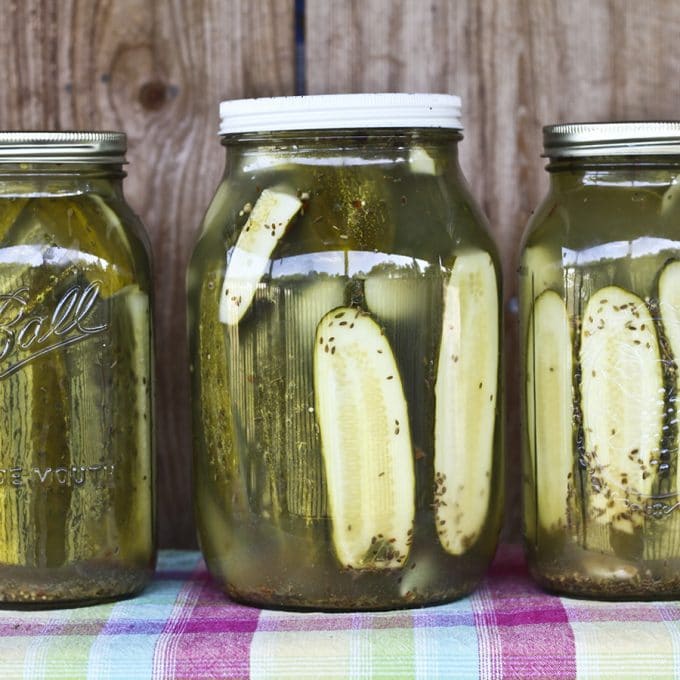
Homemade Claussen Knock-Off Pickles: Always crunchy and garlicky, this perfect homemade pickle recipe requires no special equipment, & no canning experience.
It’s common knowledge that I have a salty tooth rather than a sweet tooth. When the weather does what it has been doing lately (making us all do our best Shadrach, Meshach and Abednego impersonations) I can’t think of a single thing I find more refreshing than an icy-cold, salty, crunchy pickle.
It’s not just me, it’s my whole family: mother, sisters, brothers, cousins, aunts, grandparents, kids, husband… I married a man who loves pickles so much he eats the pickles and then drinks the juice from the jar.
I grew up eating my Grandma’s homemade dill pickles like the supply was endless and moved on to canning my own pickles as soon as I had a kitchen of my own. There’s just something about a homemade dill pickle that makes me happier than any pickled cucumber ever should.
My little sister, Jessamine, and I compare our homemade pickles from year to year the way some people compare wine vintages.
Dill Pickle Recipe
But there is one pickle that stands head-and-shoulders (were pickles to *have* heads and shoulders) above all others. I’m talking about the pickles you see here. That’s right: Homemade Claussen Dill Pickles.
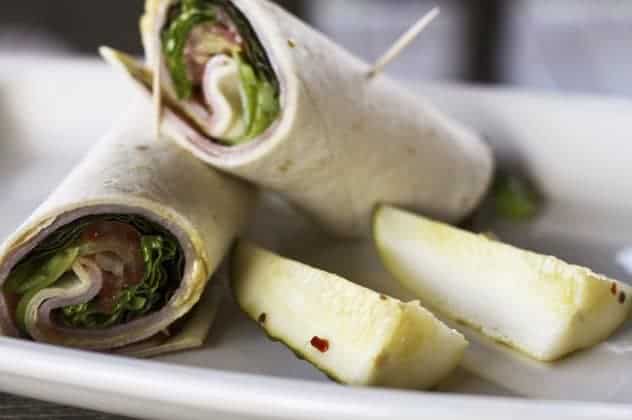
Recipe for Claussen Pickles
What do you need in order to make this recipe for Claussen Half Sour Pickles at home? Let’s get a quick list for both ingredients and equipment out of the way, shall we?
Equipment for Making Claussen Pickles at Home
- A Glass gallon jar or 4 glass quart jars or other food safe container with a tight fitting lid
- Measuring cup
- Chef’s knife or paring knife
Ingredients for Making Homemade Claussen Pickles Copycat
- Small to medium size pickling cucumbers (check your local farm stand or farmer’s market!)
- Apple Cider Vinegar (don’t fret- it doesn’t taste like apple cider and isn’t even a little sweet!) or white vinegar
- Kosher Salt
- Garlic
- Dill (either fresh or dill seed)
- Pickling spices (available here)
A quite note on your vinegar choice: I opt for apple cider vinegar because it’s a smoother vinegar than white vinegar. It does not impart any sweetness or apple taste to the pickles whatsoever.
If you can’t find it (pssst. It’s right next to white vinegar in even moderately stocked grocery stores) or don’t feel like buying it, you can most certainly substitute white vinegar. It’ll just taste a little sharper. (And technically store bought Claussen pickles have white vinegar, so you do you!)
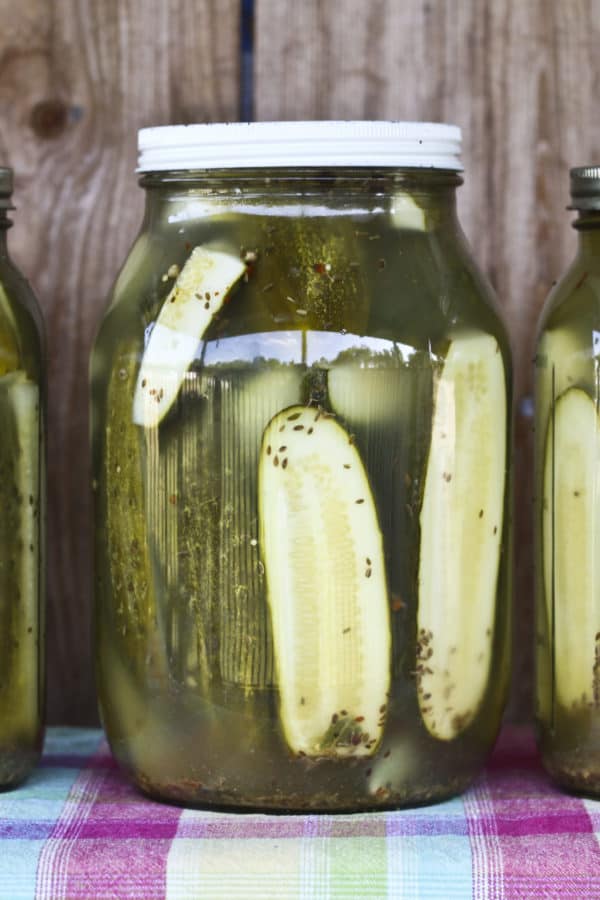
And ya’ll. These homemade half sour pickles are so easy to make it’s almost criminal.
The hardest part is the 2 to 4 day wait for them to be done. Truth be told, though, I’ve snacked on them the day after I made them and been a very happy camper.
Claussen Pickle Recipe
These are homemade refrigerated deli pickles, also known as Lithuanian half-sours, also known (in the commercial equivalent) as Claussen dill kosher pickles, also known as the best pickles ever known to mankind.
Here’s the thing. While I do love my other homemade pickles dearly (otherwise why would I continue canning ninety-something quarts year after year after year), these are by far my all-time favourites.
CRUNCH. That’s what you hear when you bite these. There is no flop, no squish, no soft pickles. These things almost bite back.
This also happens to be the perfect dill pickle recipe for beginning pickle makers. If you’re not into canning, these refrigerator pickles are a godsend. Even if you ARE canning obsessed, like yours truly, this Claussen pickle recipe should be in your pickle repertoire too.
Please note that this Claussen pickle recipe is not suitable for canning. The brine is fermented and not very acidic, which means it has far too high a PH to can safely. If you’re looking for a great canned dill pickle recipe, try this home canned garlic dill pickle recipe.
Refrigerator Pickles
Here’s where we get into the best part of this pickle recipe (aside from the crunch and flavor). You don’t have to cook anything to make these pickles; not one single thing. The brine is stirred together, the cucumbers are rinsed, trimmed and stuffed into a jar with garlic cloves and spices.
These half sour pickles are NOT CANNED. They are simply put into jars. Amen!
When it’s summer time and the idea of turning on the stove makes me want to crawl into an (air conditioned) hole, these pickles are a welcome treat. Not only is that cold crunchy refrigerator pickle waiting to cool me off at the end of the prep time, but I don’t have to heat up my kitchen by even one single degree to get there.
Remember that pickling isn’t just for cucumbers, either! Try out our Pickled Brussels Sprouts, Quick Pickled Red Onions, and famous Candied Jalapenos!
How to Make Pickles FAQ
Please, please, please give these a go even if you have never made a pickle before. There is nothing scary or intimidating here. Wash, slice, stuff, stir, pour, sit, wait.
- Trim 1/8-inch from the blossom end of each cucumber and slice them in half lengthwise or into quarters. The size you choose depends on how large your cucumbers are and how big you want the pickles to be when they’re done. This helps minimize the chances of soft pickles.
- In a gallon jar (or large, wide-mouth, food-safe container) layer the dill heads or seed, pickling spice or mustard seed, and garlic cloves and sliced cucumbers. If you’re dividing the cucumbers up between smaller containers, just divide the garlic and spices evenly between the containers, too.
- Stir your brine together in a separate container. You WILL have more brine than you have space for in the jars, but that’s why you pack the spices in the jars. Just store extra brine in a jar in the refrigerator and use it to top off your pickles if the brine starts evaporating.
- Pour the brine over the cucumbers, taking care to make sure all of them are fully submerged. If needed, place a plate or mug or other ziploc bagged can of beans on the cucumbers to weigh them down and keep them under the brine!
- Cover the jars lightly not tightly and leave out of direct sunlight on the counter for two to four days or until the pickles are picklicious.
- If your kitchen is pretty hot or humid, you can stash them directly in the refrigerator. They’ll just take a couple of days longer to get fabulous. Your patience will be rewarded.
On the plus side, the wait is only two to four days which is significantly less than the six week wait of the canned pickles. Besides, as I said, there is the crunch factor
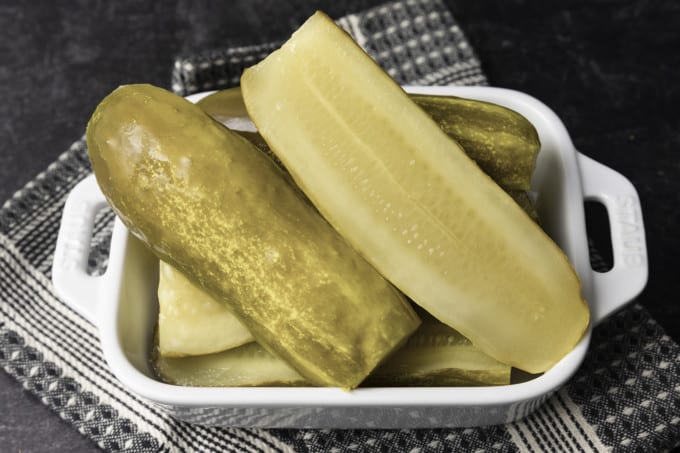
Troubleshooting Your Homemade Claussen Pickles
These pickles are easy peasy to make, but there still may be a couple of things that pop up from time to time that make you go “Hmmm…” In no particular order, here are some of the most commonly asked questions about them and some answers!
- Why is my pickle brine cloudy? Okay, I lied. This is the most common question and that’s because the brine becomes cloudy naturally as a consequence of fermentation (which is what’s happening here.) No worries.
It’s all natural. This half sour pickle recipe (more on this to come) is a fermented pickle recipe and that just happens.
Another possible cause of intense cloudiness or discolouration in your brine is using table salt. The iodine in table salt can also give off flavours to your pickles, so it’s best to stick with kosher salt or pickling salt for these bad boys! - Is the scum, foam, or film on top of my pickle brine dangerous? It’s that pesky (and delicious) fermentation again! This is another thing you don’t have to worry about.
Just scrape it off with a spoon, discard, and top off with a little of that extra brine you whipped up. (See the recipe card for details.) But do remove the scum or it could cause your pickles to go bad. - My pickles went soft! How do I prevent this? This particular tragedy could have two causes.
First, you may have failed to remove enough of the blossom end of the cucumber. There is a naturally occurring enzyme in the blossom end of cucumbers that causes pickles to break down and become soft if it is not removed. Next time, just slice more off.
Second, you may have started with less than spectacularly fresh cucumbers. An older cucumber has had longer for the aforementioned enzyme to kick in, and it has already started its work.
The best solution for this issue is to use cucumbers that have either been picked fresh that day or have been refrigerated steadily since very shortly after being picked a couple of days previously. - Why did my pickles go bad? See that second reason in the “why did my pickles go soft” bullet point? That’s one culprit.
Other potential causes of spoiled pickles are using unwashed cucumbers or fresh dill, old or decayed garlic, bad spices, lower-than-5%-acidity-vinegar, failing to remove the scum from the brine or to keep the pickles submerged in the brine, or storing your pickles in warmer conditions. When in doubt, stash them in the refrigerator! - Why is there mold on my pickles? First, you have my condolences. Second, it’s because your pickles didn’t stay submerged in the brine. That brine has enough salt and acid to prevent mold growth if the cucumbers stay under the surface.
If you’re having trouble finding something that fits in the jar to keep this from happening, try popping a can or two of tomato paste or canned beans in a zipper top bag and gently inserting that into the jar. It should weigh it down enough to do the job. - Should I worry about the white sediment in my jar? This is another one in the “don’t sweat it” category. There are two potential reasons and both are completely harmless.
It’s either a natural consequence of the fermentation or anti-caking agents in the salt. Neither harms the pickles or effects the flavour, so don’t worry! - Why is my garlic blue/green/purple? As long you inspect the garlic before it goes into your jars and it is fresh as a daisy, you have nothing to worry about. It could be the type of salt you used or it could be the variety of garlic. Some types of garlic have a natural propensity to change pretty colours in vinegar.
It also may mean that your pickles were exposed to light. When garlic is exposed to light, it starts producing chlorophyll which is green. It also may indicate that your garlic is more mature.
In that case it is caused by sulfur compounds that naturally occur in more mature garlic reacting with minute traces of copper in the vinegar., but as long as there are no other signs of spoilage (soft or squishy texture, funky smell, discoloured spots), you’re good to go.
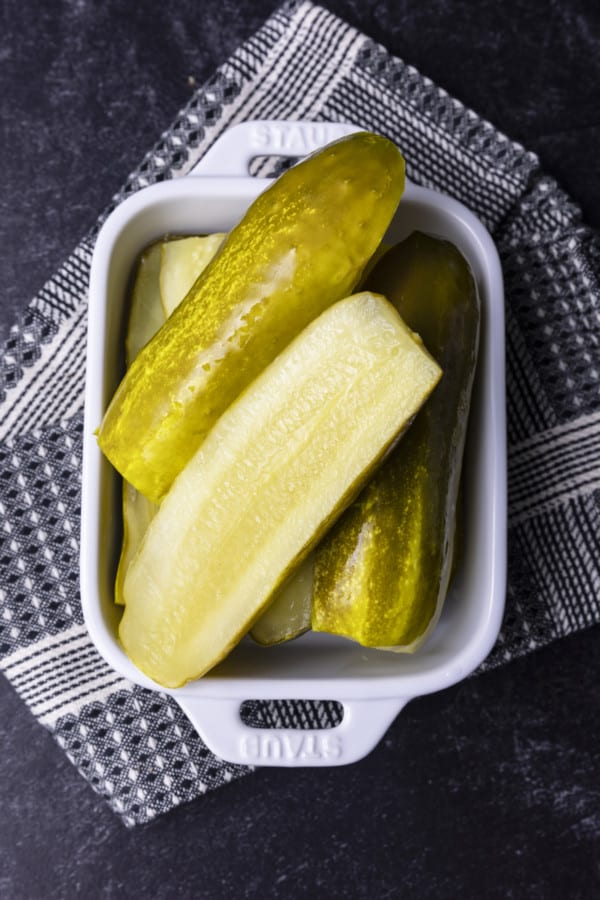
IMPORTANT NOTE: Because there is so much diversity in temperature, humidity, age of cucumbers, etc… involved in this recipe, please check your half sour pickles starting at 24 hours for doneness. If the pickles smell/taste pickley, move them to the refrigerator. Do not keep them on the counter longer than 4 days.
ANOTHER IMPORTANT NOTE: These pickles are not suitable for canning. They’re simply not acidic enough to can safely, and that is in addition to the fact that you’d ruin that perfectly crisp texture by introducing heat to the party.
What can I serve with these Homemade Claussen Knock-Off Pickles?
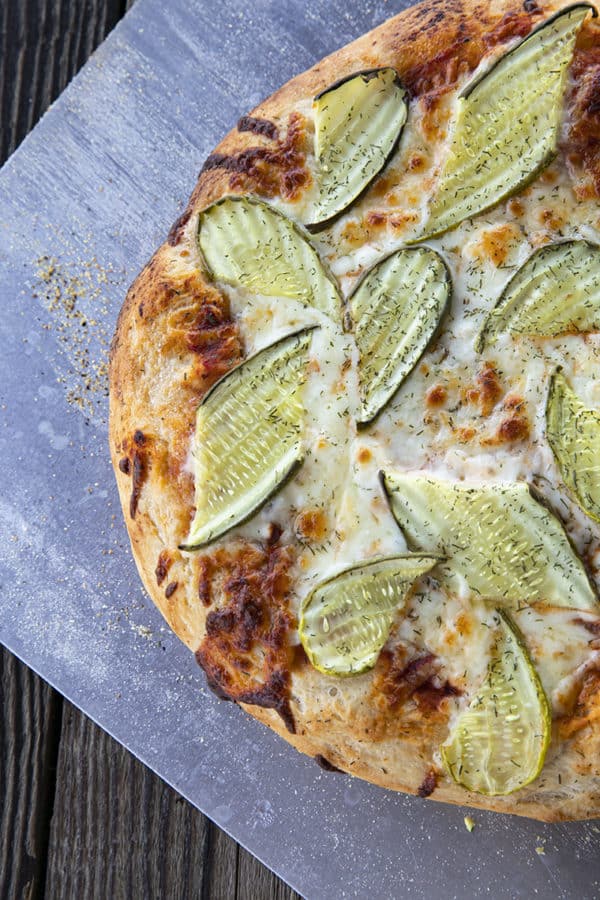
Start out by trying your half sour pickles in this Pickle de Gallo, Dill Pickle Dip, Dill Pickle Egg Salad, or Bagel Burgers with Dill Pickle Cream Cheese.
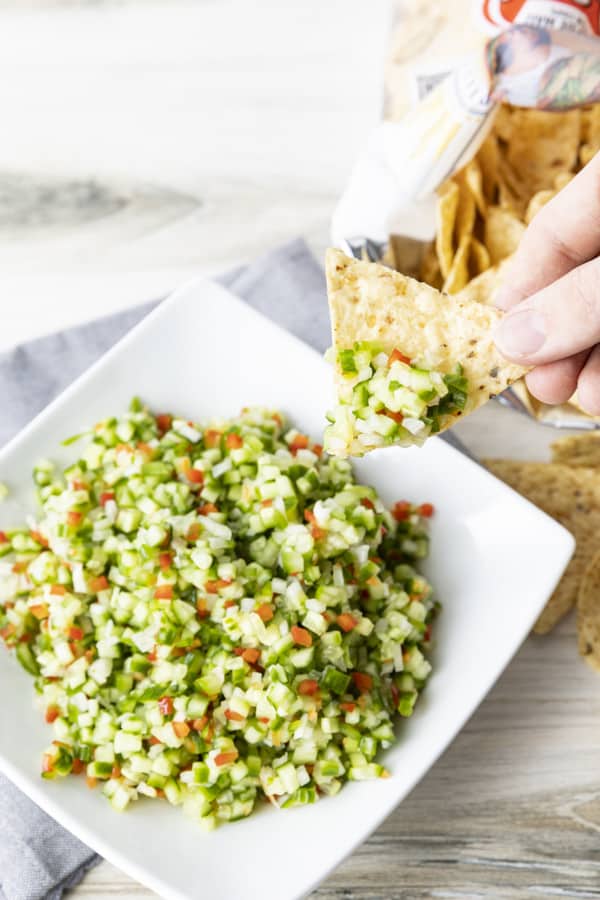
Even better, serve them on our Cheeseburger Salad or Pickle Pizza.
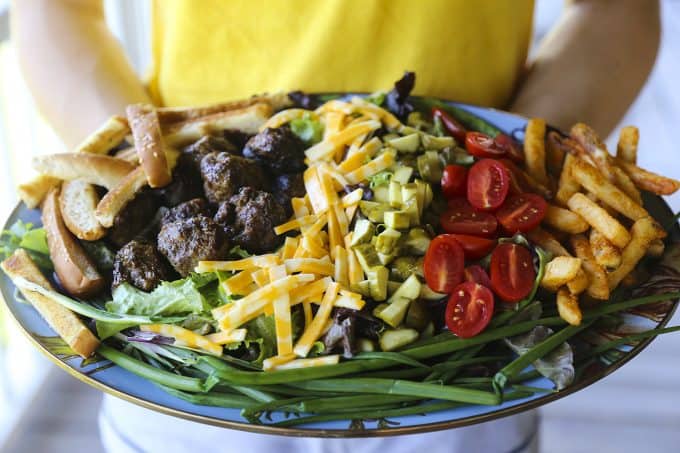
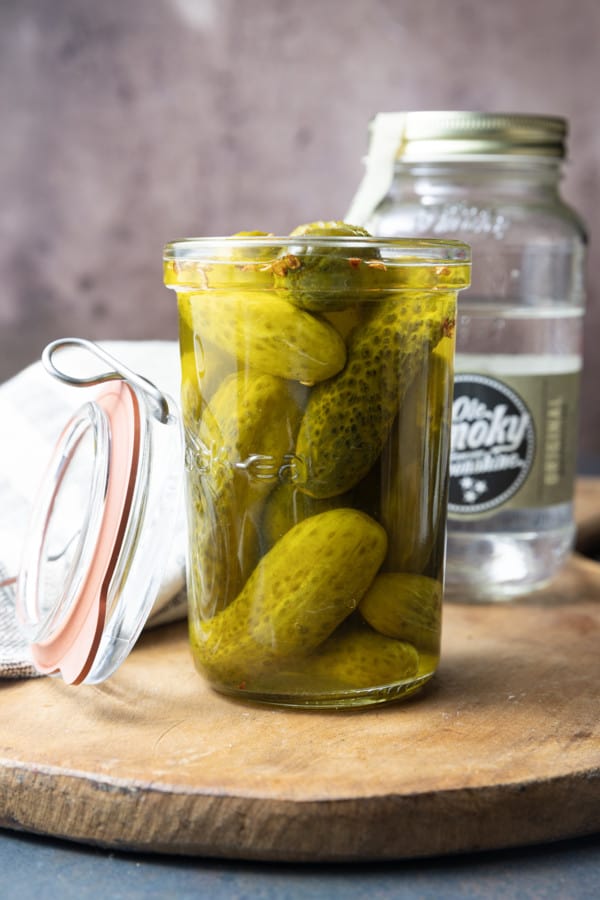
You can even take extra pickles (like that’s a thing!) and make these divine Moonshine Pickles. You’ve never had a better Bloody Mary than one made with homemade Moonshine Pickles!
Half Sour Pickle Recipe
What makes Claussen PIckles different from canned pickles? Claussen pickles, whether homemade or store bought, are a half sour pickle recipe.
That means they’re fermented instead of heat processed. That’s what gives them such great texture.
This half sour pickle recipe yields pickles that are crunchy to the point of making noise when you bite them, cold, and seriously garlicky. Canned, shelf-stable pickles can be chilled, maintain some crunch, and be as garlicky as you want them to be, but they are never, ever going to be the same thing because of science.
When you heat process a jar of pickles you are, in actuality, cooking it and a cooked pickle just plain can’t be as crunchy as an un-cooked half sour pickle recipe.
These homemade pickles keep well in the fridge for about six months, as long as they remain submerged in the brine. In our house, they never last that long because, as the saying goes, “A pickle a day keeps sad times away.”
They say that right? Someone must. If not, I’m going to start. It’s true, after all.
Claussen Pickles
Wash cucumbers but do not scrub them.
Trim 1/8-inch to 1/4-inch from the blossom end of each cucumber and slice in half lengthwise or into quarters, depending on how large your cucumbers are and how big you want them to be when they’re done.
Layer the dill heads or seed, garlic cloves, pickling spices and sliced cucumbers in a gallon jar (or large, wide-mouth, food-safe container). You can evenly divide the dill, garlic cloves, pickling spices, and cucumbers between several smaller jars if needed.
In a separate pitcher or bowl, stir together the remaining ingredients until the salt is dissolved.
Pour the brine over the cucumbers, taking care to make sure all of them are fully submerged. If needed, place a plate or mug or other non-reactive heavy item on the cucumbers to weigh them down and keep them under the brine!
Cover lightly with a lid just perched on top or secure a piece of cheesecloth over the jar with a rubber band to keep fruit flies away. Store any extra brine in a covered jar or pitcher in the refrigerator and use it to top off the brine if it starts to evaporate and expose the pickles to the air.
Leave out of direct sunlight on the counter for at least 24 hours, but up to 4 days, or until the cucumbers taste like pickles throughout.
Fix your lid onto your jar or container and chill thoroughly. These can be stored in the refrigerator for up to six months provided you keep them covered with brine.
NOTE: If at any point in the proceedings “fuzz” or “foam” develops on top of the brine, use a spoon to remove it. If there is “fuzz” attached to any of the cucumbers, remove the ones affected and be sure the others are still fully submerged.
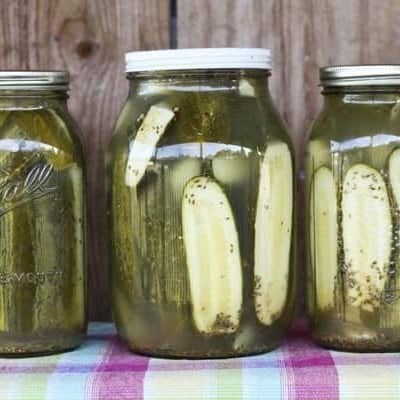
Homemade Claussen Knock-Off Pickles
Equipment
- 1 gallon jar or 4 quart jars or a large, food-safe container with a tight fitting lid
- 1 liquid measuring cup
- 1 large mixing bowl or pitcher
Ingredients
- 35 to 40 small to medium pickling cucumbers
- 1 gallon cold water
- 1 cup apple cider vinegar, preferably raw or white distilled vinegar
- 2/3 cup coarse canning or kosher salt Do NOT fine or use iodized salt!
- 4 cloves garlic or more to taste
- 4 heads fresh dill or 4 tablespoons dried dill seed not weed!
- 2 tablespoons mixed pickling spices
Instructions
- Wash cucumbers but do not scrub them.
- Trim 1/8-inch from the blossom end of each cucumber and slice in half lengthwise or into quarters, depending on how large your cucumbers are and how big you want them to be when they’re done.
- In a gallon jar (or large, wide-mouth, food-safe container) layer the dill heads or seed, garlic cloves, pickling spices and sliced cucumbers.
- In a separate pitcher or bowl, stir together the remaining ingredients until the salt is dissolved.
- Pour the brine over the cucumbers, taking care to make sure all of them are fully submerged. If needed, place a plate or mug or other non-reactive heavy item on the cucumbers to weigh them down and keep them under the brine!
- Cover lightly with a lid just perched on top or secure a piece of cheesecloth over the jar with a rubber band to keep fruit flies away.
- Leave out of direct sunlight on the counter for two to four days*, or until the cucumbers taste like pickles throughout.
- Fix your lid onto your jar or container and chill. These can be stored in the refrigerator for up to six months provided you keep them covered with brine.
- *If at any point in the proceedings “fuzz” or “foam” develops on top of the brine, use a spoon to remove it. If there is “fuzz” attached to any of the cucumbers, remove the ones affected and be sure the others are still fully submerged.
Notes
Nutrition
Nutritional information is an estimate and provided to you as a courtesy. You should calculate the nutritional information with the actual ingredients used in your recipe using your preferred nutrition calculator.
did you make this recipe?
Make sure to tag @foodiewithfam on Instagram and #hashtag it #foodiewithfamily so I can check it out!
Originally published July 22, 2011. Updated with FAQs and Troubleshooting and reposted August 2022.
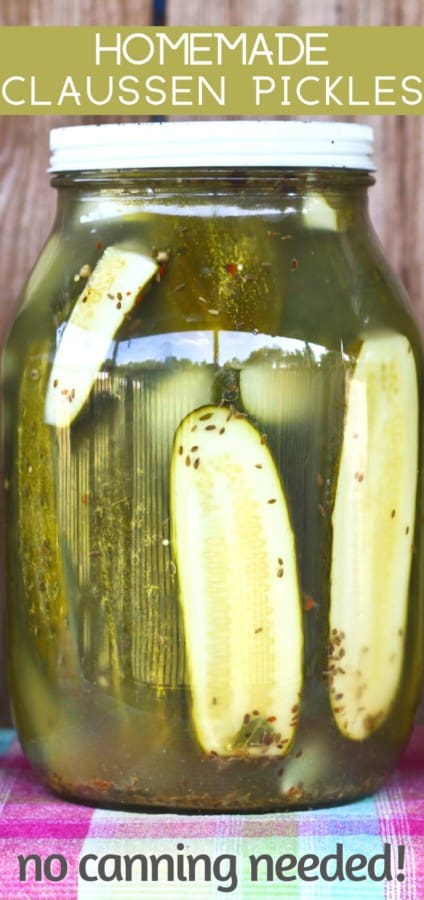
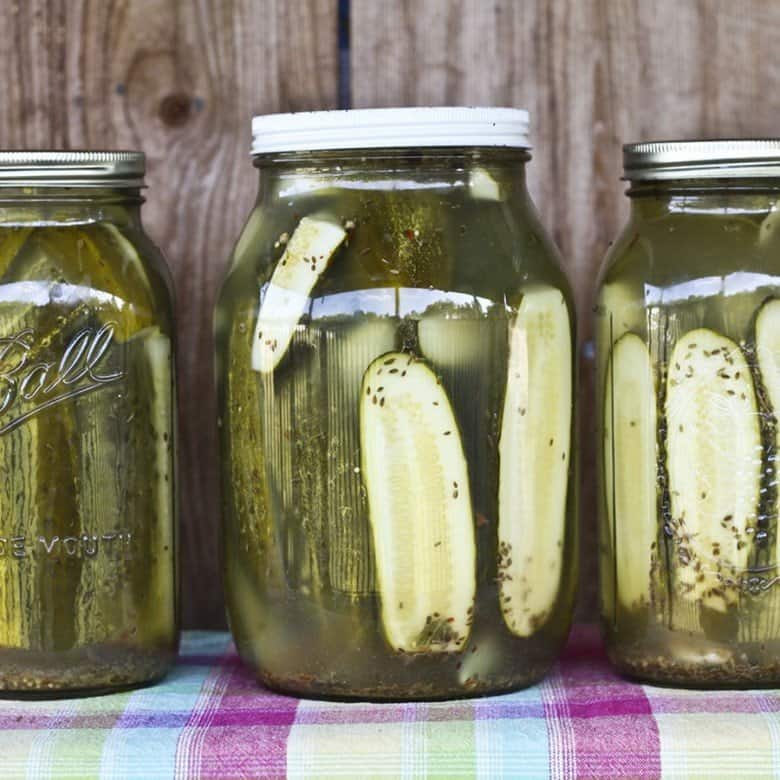
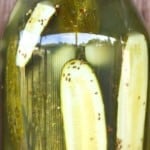



Reader's Thoughts...
Toni says
I am trying to learn whether or not a jar of Claussen pickels- UNOPENED- which had set over night on the counter (unrefridgerated) might still be safe to eat??? Claussen says they are best kept cold and will not state clearly one way or another. If yo made you knock offs- how long could they set- after being sealed- before you would throw them out?
Thank You for your time,
Toni
Rebecca says
I can’t say with confidence how good your pickles are, as it depends on many conditions. As for the knock-offs, they’ll hold until they grow fur or are slimy!
Deb says
can I make these in plastic, like tupperware?
Patti King says
Can these be made with whole pickles also? I prefer the smaller ones and not have to slice them, but most all the recipes I find tell you to slice, halve or quarter the pickles.
Mommaofmany says
I LOVE this recipe….I’ve used it for years! In fact, if you *have* to can your pickles, you can use this recipe and process in a boiling water bath for 15 minutes. They come out really good, even cooked!
Deja says
Thanks so much! I feel much better about serving these to friends now.
Now if you have a salsa recipe safe for canning that does not include canned (store bought) tomatoes, my summer would be complete!
Martin says
Thanks for the recipe, this is exactly what I’ve been looking for. Can’t wait to try it. Just one question: I have a pouch of Mrs. Wages quick process dill pickle mix. Will this work for the spices for your recipe?
Thanks!
Rebecca says
Hi Martin- I hate to say I don’t know, but I don’t! I’m not familiar with what is in Mrs. Wage’s pickle mix. The pickling spices I use are just plain old spices: no salts or other items like that. I would advise checking the packet to see if it is pure spices…
Joe says
what do you use for your picking spices?? I have a mix that I like, but it is for pickled peppers, so I’m wondering what I might be leaving out that would be good with pickles.
Rebecca says
Hey there, Joe! I tend to leave out the cloves and cinnamon bark on mine. For some reason, the flavour of those just kind of hops out at me. So in short, I either sift through and pick those out of a purchased pickling spice, or combine my own!
Deja says
I made these, and on the morning of the fourth day I woke up to foggy brine. They smell nice and fermented, taste fine (says my husband), but is that OK? I put them in the fridge right away, but are they safe?
Rebecca says
If they still taste fine, and there’s no “fur” on the pickles then they’re dandy! No worries. That happens as part of the fermentation process naturally sometimes.
Penny Baugher says
I have what looks like mold on mine? ?
Rebecca says
Depending on the type of mold, you can skim the top, remove anything in contact with the mold, and be okay.
CrackerjackHeart says
Hey Deja-
Hard water minerals can make your brine cloudy. If it bothers you, try using distilled water.
Heather says
I just made these this morning. They are sitting on my counter now. I used my large stockpot and put a plate on top of the cucumbers to make sure they were all submerged. This is the first time I have ever made pickles, I hope they turn out good. I also put the pot lid on upside down since I didn’t have cheesecloth.
Morgan says
I am confused about the very last part too!
Fix your lid onto your jar or container and chill. These can be stored in the refrigerator for up to six months provided you keep them covered with brine.
Cover the jar lightly. Do not screw a lid into place!
Do you mean to screw the lid into place??? Please help as these sound AMAZING I really do want to make them.
Rebecca says
Boy! I was wondering why everyone was so confused by that direction until I realized that the sentence I thought I had deleted had actually been moved to the bottom of the recipe. My apologies to everyone. The instruction to put the lid on lightly and not screw into place applies ONLY to the time it is on the counter top! You can put it on more tightly in the refrigerator. Of course, it being a naturally fermented product, it’s still going to give off a little gas, but as long as you’re opening the jar regularly to fish out a pickle or two it should be able to release those gasses enough 🙂
Jennifer @ Jane Deere says
I have been looking for a recipe to mimick Claussen! Yay, I can’t wait to make these! Thanks! Congrats on your TK feature too!
kati says
this is exactly what i was looking for!! i can’t wait to make these, i have cucumbers coming out of my ears, lol.
Nancy says
Thank you SO much for posting this recipe. I made them Friday and just had my first pickle of the batch today. Simply put, they are amazing! Thank you!!!
Jennifer says
I love you! And my husband will too. I think we have 4-6 jars of Claussens in our fridge right now.
Jo says
I love you too
Cindy B. says
Claussen are my favorite, the only pickle I’ll eat! Thank you!
Debora Cadene says
Just found your site and absolutely cannot wait to do some of the canning you have listed. I don’t have a large enough container to put these into all at once, which I think is what you are saying. Would I be able to do this in individual jars? and how much dill and garlic would I put into each jar? And would they have to be in a fridge or could they go on the pantry shelf if the room is cool?
Can’t wait to try some of your recipies.
Debora Cadene,
Atikokan Ontario
Rebecca says
I’m sorry it took so long to respond, Debora. You can certainly put them into smaller containers, just divide the ingredients between them. As to how much to put into each container, it sort of depends on the size you use. I’d say use four quarts instead and then you can divide everything into four!
Tommy says
Hey I made the pickles, they taste good, but my brine in the jar is cloudy, does that mean they are not any good? Made a gallon jug of them. Had very little form on top when they were ready in 4 days.
Rebecca says
Cloudy brine is not bad, as long as you don’t have hair or fur at the top 😀
CrackerjackHeart says
Hey Tommy-
Hard water minerals can make your brine cloudy. If it bothers you, try using distilled water.
Chris says
Awesome. Works great. I make them all the time.
I call them short pickles. I make them and the brine. Leave them on th counter foruse bottled water. You have so much vinegar, salt garlic and dill that nothing bad will live in the brine for months.
Debbie O'Berry says
Anti-caking ingredients in salt will make the brine cloudy.
Joanne Burneson says
Made these.. No fuzz .. I’ve had them sitting on counter covered with brine for a week..should they be in refrigerator?
Rebecca says
It sounds like a good time to stick them in the refrigerator!
Michelle says
never made pickles before – how should I cover tightly without screwing a lid on?
Wayne Baker says
Not tightly. Lightly.
Jayne Hartsell says
Wayne Baker, is your wife’s name Ruby?
Jayne Bell Hartsell
Yvonne says
My family loves Claussen’s pickles – they were my very first one. My mom used to spear pickles on a fork and we’d lollygag outside during the summer with our delicious, cold, crisp, salty pickles. It was heaven. I can’t wait share this recipe with my family and try making them!
Ranee @ Arabian Knits says
My husband also drinks pickle juice! And I love these pickles.
Lisa@The Cutting Edge of Ordinary says
OMG….we are a pickle lovin’ family too and Clausen’s are our faves and guess what I have growing in my garden? Pickling cukes! I’m so making these! I know a jar will last like 10 mins in this house.
I know I have told you this before but I have to say it again…I love your sisters name. Jessamine. I think if I had a girl I’d name her that, that’s how much I love it. My oldest is Jesse, so maybe I’m just stuck on a Jess thing.
Rebecca says
Saint Tigerlily- Holla!
Carrie- Oh, you will soon enough… I make these hand-over-fist while my cucumber plants are at their peak production.
Lisa- I love my sister’s name, too! And the pickles will disappear faster than you can make them. I’d advise starting a new batch every third day 🙂
Donna says
What pickling spices do you use
Carrie @ poet in the pantry says
Love it! Now if only I had more than a handful of pickling cucumbers ripe at the same time!
Saint Tigerlily says
I hear you!
Pierre says
I keep then whole and I freeze them for a hour before jarring them the is a secret to make them crunchy
Peggy says
That really works? My pickles aren’t crunchy and that drives me nuts!! Lol I’ll try it! Thx
Marcia says
Ball Pickle Crisp is great for keeping pickles crisp. It’s just calcium chloride so its very safe.
Jessica says
I am so excited to be heading out to the farm to pick up my box of cucumbers today. I’m wondering about the amount of pickles going in one jar. It’s unclear if the gallon size jar is for all of the cucumbers in the recipe or if I need several? And is this enough brine for 35-40 cucumbers? Feeling a little anxiety as a first timer!
Rebecca says
No worries, Jessica! That is plenty of brine for a gallon or two of pickles, and those gallon jars (or quart or half gallon, what have you) will fit as many cucumbers as you can cram in there. 🙂
Carol says
Cut off blossom ends and put cucumbers in ice water overnight in refrigerator.
Jami says
I use two grape leaves per quart jar for crunchy pickles.
The spice Alum works as well, but I prefer to pick a few grape leaves.
Good luck(:
Jacquelene Lively says
No better pickle and I love them all..
Ray says
Great Idea. I wonder if u could leavevthem in the refrigerator for the 2-4 day pickling to finish. It’d also help with crunchiness. I’ll try your tip
Debra says
Did you try putting them straight into the fridge?
DC says
yes strait into frig and a spoon of sugars .
I liked jalf water and half vinager
David White says
We pickle in the fridge just takes longer
rachel iannotti says
does it make them crunchier?
Denise says
I put a Lipton tea bag in the bottom of each jar. That seems to keep them crunchy as well. It’s the tannins in the tea that keep them crunchy.
Rebecca says
I have never heard that tip before. Thank you, Denise!
Linda Nelson says
a new bag of lipton tea or used? if new, does it change the color of the liquid or cucumbers?
Jimmy Robert says
You can also add Oak Leaves for tannins as they have more than grape leaves or raspberry leaves
Rick says
Can the left over brine be refrigerated to be used at a later time?
Rebecca says
Hi Rick- I add a splash of the old brine into new batches -kind of like a starter- but I never reuse it for a fresh batch of cucumbers. I do, however, reuse it once in another way; tossing in cauliflower, carrot coins, celery, onions, etc…for a quick giardiniera or chow chow type pickle salad.
Mel Wilkinson says
Can you use Persian pickles ?can you use Persian cucumbers ?
Frankie says
I love the idea! Canned pickles for years.
Someone gave me a 5 gallon bucket of burples cucmbers will they work on this recipe? Please answer!
Rebecca says
Hi Frankie- Actually you won’t be canning these. 🙂 And I’m not sure how burpless cucumbers differ from pickling cucumbers. If they were free, I’d give it a try with some of them!